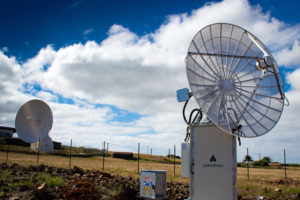Hi Jonata, the annual Small Satellite Conference has just concluded, what are the key take away from Leaf Space?
It has been a week dense of emotions and discoveries. After some months of lock downs across the globe, we have been able to convey again with many of our current and future clients, and industry colleagues too. We also realized that the new space economy never actually stopped. It continued working to have commercially operational smallsat constellations despite the inevitable launch delays. Most of our customers are pushing to get their satellites in orbit as soon as possible and at the same time focusing on their next-generation satellites. In turn, we are scaling up of our ground network and improving the services overall to always provide them a simple, reliable and cost-effective Ground Segment as a Service solution.
How is your Leaf Line ground network growing?

During spring, in the middle of the COVID-19 outbreak, we secured a series A funding that triggered the scale up plan of Lead Space. We are now proceeding in activating new sites worldwide and installing new ground stations. We have just cut the ribbon on our new GS in the Azores that will provide enhanced coverage in the Atlantic, and we have few ground stations ready to be shipped to new sites in New Zealand, North America and the equatorial region. We are also installing additional antennas in our historic location in Spain, and soon we will have a new location in East Europe. The pandemic has slowed down the roll out planned for Q2 2020 a bit, but now we are catching up. All these new locations are very attractive not only for satellite missions, our main vertical, but also for the increasing need coming from new and established launch vehicle operators.
Tell me more about launch vehicles, and how Leaf Space is supporting this part of the market.
In 2019 Leaf Space was selected to support the final testing campaign of Virgin Orbit’s LauncherOne vehicle, an experience that has been really fruitful to gain operational know-how. Right now, we are developing new solutions to better support this kind of test and launch campaign with an “as a Service” model, that is our real key added value. All this added to the fact that our ground stations are flexible and compact so they can be easily deployed in different spaceports or launch facilities. Also, we have started providing LEOP services to satellites also through Launch Brokers, which provides a better and more comprehensive service to their customers.
Why should clients buy Ground Segment Services from Leaf Space and not build their own network or rely on other providers?
For microsatellite operators, the ground segment in general is seen as a key part of their business, but as it is not the core of their business managing this internally is actually seen as a disadvantage. What they really want to focus on is harvesting data from space, processing that data and delivering it to the end users. In addition, efficiently managing a ground station network is not an easy task. If you think about the multiple hardware and software blocks needed to guarantee a secure and reliable communication, all the regulatory challenges and the specific skills you need to deploy and run a network, this is clearly something that many operators handover to a specialized partner. This is especially true if your partner can provide a more reliable and cost-effective solution thanks to the distributed nature of our network and high degree of automation, from load balancing to rescheduling. We’ve made a webinar on this topic during the Smallsat Conference that will be published soon!
What are your main objectives for the upcoming months?
Well, we have customers in the major part of the rockets scheduled to launch from now to the end of the year and we will support them not only during LEOPs but also through our services Leaf Line and Leaf Key.
On the R&D side we’re working on both increasing the performance of the Ground Stations composing our network, to allow faster data downlink and even support higher frequencies, but also on supporting an even wider range of MODCOD schemes and protocols in order to decrease the onboarding time of our customers.
On a revenue perspective, last year we had already significant revenues, and we plan to double this year and have a quite growing trend after that.
To get more traction on the US market we will soon open a new subsidiary there; we already have people working from the US, but we think that a legal entity will provide us even more visibility both to commercial and institutional market.
So, we’re quite busy!

